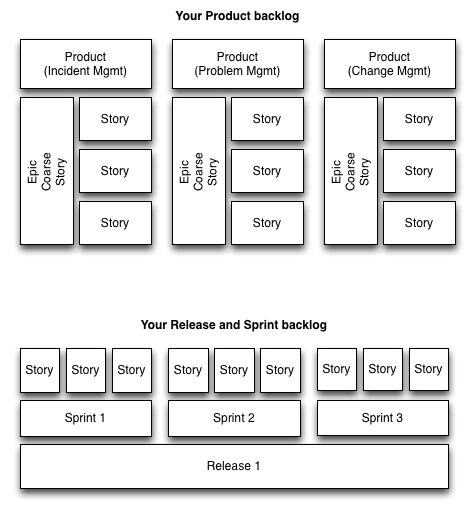
- Subscribe to RSS Feed
- Mark as New
- Mark as Read
- Bookmark
- Subscribe
- Printer Friendly Page
- Report Inappropriate Content
Our product is widely recognised to be a market leader in the IT Service (and Support!) Management industry. Our core competency of applications to help organisations manage their Incident, Problem, Change, Knowledge and Configuration processes are well known and used by our customers.
But that's only half the story. Outside of that core set of ITSM applications customers have access to a wide variety of other business applications - Project and Portfolio Management, IT Governance Risk and Compliance, Cost Management, Asset Management and more.
In the Berlin release we gave our Software Development Lifecycle range of products an overhaul and introduced a new and improved Scrum Process pack.
I'm a big fan of both the Agile/Scrum methodology (I blog about that here) and our implementation in the product.
Over a couple of future blog posts I'm going to run through the improvements in detail and give my thoughts on best practice and usage
Big ideas in this blog post
Click to tweet below.
- The process pack has new data models for Scrum artefacts
- Customers using the Scrum process pack have an opportunity to integrate their Agile and ITSM process...
- Progress boards allow teams to focus in on sprint objectives
- Automatically updated burndown charts allow teams to visualise remaining work
- Planning boards allow stories to be allocated to sprints up to a teams capacity
- Velocity charts allow Product Owners to plan future iterations based on previous sprint progress
New data models
The process pack enhances some existing data models to represent Scrum artefacts and introduces new ones.
In summary there are models for:
- Product: To associate existing and future features into a product that is "owned" by a single Product Owner
- Theme: A sub-set of features within a product that allow the Product Owner to organise his product
- Epic: A grouping of story objects to allow the PO to map his product vision out. Also allows the Scrum team to resize features (Storys) for better estimation and planning
- Story: A user feature containing information about the functionality required, an estimation of effort and the current state of that feature
- Release: A time-boxed activity to produce a releasable version of the product
- Sprint: A time-boxed activity to produce a potentially releasable iteration of the product
- Scrum task: A unit of work completed by a single team member

Integrating Agile with Project Management and ITSM
The most exciting aspect of a new and improved way to support our customers implementation of Scrum lies outside of the product itself. The data models, progress boards and burndown charts are all cool but the real potential for our customers is in the possibility of integrating their ITSM, Agile and project management methodologies.
Developing IT Solutions using Agile techniques is only half the story. Solutions need to be transitioned into production environments and maintained through the lifecycle.
Having a single solution that excels in both Agile SDLC and IT Service Management and allows tight integration gives our customers a platform to get their Operational and Development working side-by-side.
I'm really looking forward to seeing a customers DevOps implementation using the ServiceNow platform.
Progress boards
Scrum teams organise their work in an prioritised list of Stories. Traditionally teams work from paper cards on a "Scrum board" which is great prop to build collaboration and focus.

Physical Scrum boards are essential for any team - we've complemented the physical board with a digital counterpart.
The Scrum process pack includes a digital progress board for remote team members, managers and Product Owners to see how the sprint is going.
Cards (Stories) can be dragged across the progress board to change state - from Draft to Complete. Team members can edit stories within the board and add tasks to stories.

Burndown charts
We've taken another Scrum analog tool for managing the sprint and created a version in the platform.
The burndown chart allows the team to see how much work is done and how much remains during the sprint. The ideal line visualises far ahead (or behind) the team is at a point in time
Burndown charts allow ScrumMasters and Product Owners to evaluate risk early on and see if commitments might slip within a sprint.

Planning boards
Release and Sprint planning are critical activities in the scrum process. Effective planning relies on being able to rank stories by priority and to have the team commit to the amount of work they are able to complete.
To help with this the Planning board allows reordering of stories by dragging. You are also able to drag stories into a sprint and review a percentage counter which indicates the teams remaining capacity based on their velocity.

Velocity charts show historical progress for future planning
As a scrum team works through multiple sprints they will start to understand their velocity, described in a number of story points.
The Scrum process pack includes charts that show historical velocity so that Product Owners can plan future iterations.

In summary...
This was a one-hundred-mile-per-hour tour of the new Scrum features in the Berlin version of ServiceNow. New data models, unified processes between your ITSM and Agile teams (DevOps?), progress boards, burndown charts, planning boards, and Velocity charts are great capabilities available to software development teams now.
I'll be covering all in future blog posts.
Photo credit
You must be a registered user to add a comment. If you've already registered, sign in. Otherwise, register and sign in.

